Regular readers of this site (ok, my mother) think I spend most of my time walking about Cape Ann and occasionally other places, meeting interesting people, and then writing about them. Yes, this is my “process.” :-) Recently, I ran into Barbara Lynch on her cigarette break in front of her new restaurant The Rudder, which practically dips its toes into Gloucester Harbor on Rocky Neck.
Rocky Neck is an artist colony that has been home to many artists including Emile Gruppe (his son Robert has a studio there now), Childe Hassam, Jane Peterson, and Milton Avery, who makes multiple appearances in this story. Now Rocky Neck is home base for a star chef who has had quite the rollercoaster life. Barbara grew up in the South Boston projects and did a lot of fending for herself. She tells her at-times turbulent story in her book, Out of Line: A Life of Playing with Fire.
She would go on to become a celebrated chef, earning two James Beard Awards and becoming the undisputed queen of fine dining in Boston. No. 9 Park changed the Boston dining scene. The Butcher Shop and B&G Oysters became the surrogate dining rooms of many city dwellers. She nurtured many notable chefs who would go on to open their own restaurants.
Her tumultuous life reached a low point during COVID and its significant impact on dining out, both inside the kitchen and out front. But she is a survivor. These days, she seeks tranquility by returning to her roots: focusing on being a great chef and serving her community of Gloucester. Remarkably, one way she finds tranquility is through painting. Inspired by the likes of Milton, Sally, and March Avery, she loves to paint as an artistic expression that has common ground with cooking. As a chef who has blended Italian and French cuisine in inventive and sometimes quite precise ways, Barbara chooses the representational side of abstract—the abstract side of representation if you prefer.
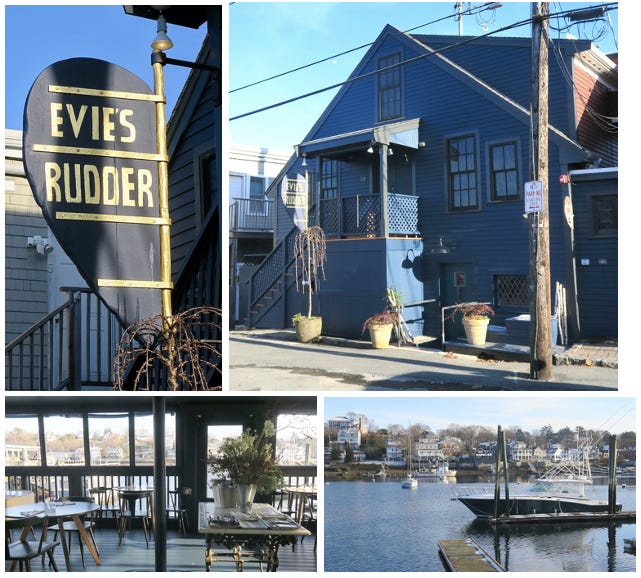
By opening The Rudder with its waterfront location, Barbara feels she’s come full circle from her first executive chef job on a dinner cruise ship (she talked her way into it and had to learn lightning-fast how to turn out a sizable number of meals in the ship’s tiny galley). The dark cerulean blue walls of the restaurant feature Barbara’s own paintings plus some by Rocky Neck artists Vanessa Michalak, Stephen LaPierre, and Jason Burroughs.
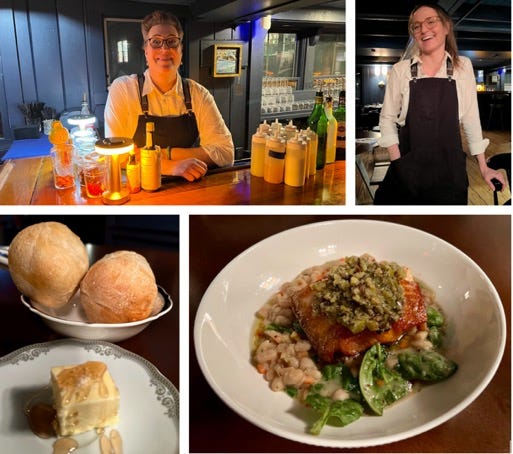
Chefs are often described as culinary artists, and some create art on canvas as well as on the plate. There’s Jacques Pepin, who recently published a book of his chicken paintings, and Barbara, who was an artist in residence at the Isabella Stewart Gardner Museum. Her paintings were part of a recent show at the Cove Gallery, a short walk from her restaurant. A few other chefs have taken up painting. But think about it: nearly every dish they create is gone in a relative moment. Their paintings can live on.
For those who have met Barbara or heard her interviewed, you might agree that you can take the girl out of Southie, but you can’t take the Southie out of the girl. Ok, I’ll be more direct: Barbara presented me with a decision not covered in the Palate & Palette Style Guide: how to handle F bombs. On this point, I consulted my editorial board—my cat—who responded with a yawn and went back to cleaning his paws. So, here’s my recent conversation with Barbara during a late November afternoon at her studio above the restaurant, expletives not deleted. In the spirit of Palate & Palette, we stuck to the subjects of cooking and painting. Stick around until the end for some surprise guest appearances.
When did you start painting?
About 12 years ago. I had never before taken a vacation and I was taking six months off work. I was flipping through a catalog from Provincetown Art Museum and my finger landed on an oil painting class. I signed up and I still remember the first day of class. I was so nervous.
Did you get over your nervousness about painting?
Yes, and then I was hooked.
Do you feel like you’ve found your style of painting?
I think I'm understanding it now more than ever. I’ve started to realize how each color drags into the other color. I’ve changed how I start a painting; I don't believe in starting with dark colors anymore.
Tell me about sharing your art with others.
Showing my art has been fun. I've never done it before. It put a little light under my ass to say, "Keep going. Keep going."
You’ve made a few paintings of food.
Yes, this one [pointing] is eggplant salad, which was one of my first dishes at No. 9 Park.

You were the first chef to be an artist in residence at the Isabella Stewart Gardner Museum. What was that experience like?
So f***ing cool. It was like I was actually living in the museum. I had a curfew!
What was it like to live there? Could you walk around in your pajamas at night and look at the paintings?
I did take the midnight tour a few times [which involved viewing the art by flashlight]. I had full access to the library. I fell in love with the John Singer Sargent paintings, the archive room with all the notes and love letters, and the restoration room. One time, I created a dinner as a chef living through Isabella.
Barbara was drawn to an altarpiece in the Long Gallery, The Virgin and Child Enthroned with Saints, by Giuliano da Rimini. Admiring the pattern on the Madonna’s gown, she translated it into a pasta stamp that she used in a pasta-making workshop. After the residency, Barbara returned to the museum to give pasta-making workshops and host a dinner inspired by her time observing the art collection. She recalls intricately folding a specific type of pasta to resemble birds.

You’ve said you are inspired by Milton Avery. Tell me more.
I'm attracted to his colors, the movement in his painting, and how he paints curves.
Milton Avery’s style is subtle but identifiable. I love his treatment of the horizon. He doesn't try too hard. His paintings reach people. Sally Michel Avery [Milton’s wife] was brilliant as well. I'm not especially drawn to Hopper [for artistic inspiration]. Although I like Hopper, it's just not me. I'm fascinated with Picasso too. Creatively, I'm as inspired by artists as I am inspired by chefs.
Who are the chefs who inspire you?
Alain Ducasse. He has three 3-Michelin-starred restaurants. He’s freaking consistent. Another hero is Joël Robuchon, a brilliant chef in France. He created L’Atelier de Joel Robuchon restaurant in France. I love how he did it counter-style, and it totally pissed the French resolve because they prefer bistro style dining. Gualtiero Marchesi is my hero [Gualtiero is considered to be the founder of new Italian cuisine and was the first chef in Italy to obtain three Michelin stars]. I named my daughter, Marchesa, after him.
What did you admire about Gualtiero?
He was always about [working with] three ingredients. He was way ahead of his time. His first restaurant in Milan was shunned because it wasn't like a trattoria—it was brilliant gourmet food in an elegant Italian restaurant. He went up north past Bergamot and opened a restaurant [overlooking] Lake Cuomo. I never had calamari the size of a baby’s fingernail with saffron and olives. It was freaking delicious!
The thread that runs through your biography is your boldness.
I’m a risk taker.
Do you think you have been a risk-taker with the cuisine and food that you put forth?
I don't know. I've been dyslexic my whole life, and I never knew it until I was in my 40s. How I got from point A to point B, I don't even know. It's always harder for me to understand things, so when something's just not f***ing working for me, I'm going to make it work. I'm going to do it my way. Then I'll teach them my way. So that's how I worked. That's how I still work.
My cuisine is not following a formula. If I was cooking the food that I eat every day for my customers, you'd be horrified.
Why? What do you cook for yourself?
Tuna fish sandwiches and oatmeal and peanut butter and jelly. I could eat that every day. I still love my mother's tuna fish sandwiches, and the ingredients had to be specific: Cain's mayonnaise and Star-Kist tuna, solid white. I grew up on frozen HoJo’s macaroni and cheese. Who invented it? F***ing Jacques Pepin! I love Jacques. [Jacques Pepin created many iconic recipes when he was director of research and new development for Howard Johnson’s.]
What do you eat for breakfast?
Today, I had chickpea flour cooked like panisse, with porcini mushrooms. Do you want some? [Whoa. The next thing I know, Barbara Freaking Lynch is making me lunch in her studio kitchen! It was the best thing I’ve tasted this year: a creamy Parmesan-rich porridge topped with succulent, meaty, toothsome porcini mushrooms.]
The Rudder menu has a whole section of tribute dishes.
Yes. The JFK stew is Lydia Shire's dish. She took over Locke-Ober [the fourth oldest restaurant in Boston]. She's my partner in crime. I love her. There's also a crab salad, which is a tribute to Jasper White [an authority on seafood and New England food]. He's another friend. There’s also chicken Marchesa, named after my daughter. It’s a chicken cutlet and I make it just like one of my friends growing up, Eileen Cavallari’s mother, used to make it.
How do you describe your cooking?
I go by seasons, and I like fresh food. Nothing that comes off a Sysco truck.
I like to cook old-school too. And new, but not really new. It's French and Italian, and the Frenchies hate it and the Italians hate it because they usually don't mix. Who puts f***ing foie gras with prune-stuffed gnocchi? I don't know, but it works.
Your prune gnocchi is one of your signature dishes.
That put me on the map.

When you're thinking about a dish, how are you balancing the tastes and textures?
The goal is usually three textures in a dish, so as an example: soft, crunchy, fatty.
I noticed your notebook contains many sketches of food. Given that you're a painter and think visually, when you are creating a dish, how does visual presentation come into play?
That's the hardest part—producing what you have in your head with the actual food. But I’ve been cooking for 30-plus years, and now I think less is more.
Besides your restaurant, where do you like to eat or hang out in this area?
I love Talise [in the spot of the former Market in Annisquam], and Lobsta Land—everything about it is great. I also like Crow’s Nest [For nonlocal readers, that’s where the fishermen of the Andrea Gale, the subject of The Perfect Storm, spent time and where George Clooney and Brad Pitt hung out while making the movie].
Julia Child, who you crank-called as a teenager, wrote about a pivotal moment when she first went to France and tasted sole meunière and life was never the same again. Did you ever have a moment where you tasted something or experienced food in a way that was life-changing?
Yes, but mine is more ghetto. When I was eleven or twelve, I saw a recipe in one of my mother’s Good Housekeeping magazines for stir-fry.
Did she make it for you?
God, no. I read the recipe and thought, all the ingredients look so intimidating. But I made it, and it was so good. Around that time, I used to talk to myself, saying, "I'm going to be a chef. I'm going to be a chef."

What do you think when people say, "You know, Barbara, I'd love to have you come over for dinner, but I'd be way too intimidated to cook for you"?
That's stupid. Serve me Cheerios and I'll be happy.
Do you ever follow recipes these days or do you cook by instinct?
If I'm baking, then usually I follow a recipe. But I know how to improvise really well. I'm not really good with molecular gastronomy because that’s not my world.
Do you like molecular gastronomy as someone consuming it, tasting it?
Not really. It's too much for my brain. I went to Alinea and 32 courses later, I was just exhausted. I loved Noma [a former Copenhagen restaurant focused on inventive Nordic foraged food], but I thought, "This is just f***ing crazy."
What aspect of cooking do you like to teach?
I like to demystify the art of cooking. It’s not difficult.
What advice do you have for someone who wants to be a better cook?
Focus on one thing. Think about what cuisine you love and keep cooking.
In what ways do you think painting and cooking are similar for you?
It's all about making something happen. You could paint a line and it f***ing looks good. What I love is learning about curves and the perception of where light is.
I’ve gotten to the point of thinking: how many f***ing times can I cook lamb chops or this or that? When I’ve hit a plateau, it forces me to recreate. I want to remove things and focus on less is more. The beauty is in the products [restaurant-speak for ingredients and the desire to showcase the taste of high-quality ingredients]. I think it's an important time to cook at home again.
Do you think you're moving toward a home-cooking feel at The Rudder?
I'm thinking more like Julia, cooking French and Italian. But I also love cooking Burmese food. I think about The Butcher Shop, she'd be 21 years old, and I just sold it. [The Butcher Shop was a restaurant in the South End of Boston. It had a full-service butcher shop where you could buy an array of meat, poultry, sausages, and prepared food.]
Those were some of my best years because it brought me back to Italy and France. Customers were buying goose. We were rendering beef. It was a full-on butcher shop, and we made pates, salamis, terrines. I love all that.
How do you think about the business you built?
I grew so fast and then I became this owner that had to deal with situations that I never wanted to deal with. I really like to be the creative person. I don't like to be a CEO. There's more to come on that side of all that happened. But I've put out some good chefs that have great restaurants, and I'm really proud of that.
I was approached about making a documentary, but I'm not ready for that. I have more to do. [Barbara showed me an 8-minute promo created by a major studio for an unmade documentary based on her biography, Out of Line. It began with her upbringing in South Boston, numerous traumatic and formative experiences in her childhood, and her path to becoming a highly celebrated Boston chef at the head of a Boston-based restaurant empire.]
What do you want to do?
Create things that don't exist.
Like what?
There are so many things I want to do in this community. There are so many brilliant people here who happen to be older. They need a hangout and more support to make sure they get healthcare, pet care, and other essential things.
Palate & Palette menu
At this point in the piece, I usually describe what I would cook for my interviewee. But Barbara has dined at some of the best restaurants all around the world and effortlessly turns out elaborate meals, so cooking for her is daunting.
I needed expert advice on this matter, so I reached out to a couple more of my culinary heroes, Ruth Reichl, former editor in chief of Gourmet magazine and groundbreaking restaurant critic who writes the fabulous La Briffe, and Susan Spungen, cookbook author, food stylist (including for the movie Julie and Julia), creator of the most artful cookies I’ve ever seen, and writer of the wonderful Susanality Substack. It was a “cold call” for advice, peppered with flattery! :-)
I was delighted when Ruth Reichl responded:
“This is how I think about it: I'm not a chef and they know it. So I just cook solid food I feel comfortable with. Most chefs don't cook much at home—if at all—and are grateful for solid home cooking. I think I made chili the last time I cooked dinner for Nancy Silverton and she liked it so much she refused the turkey at Thanksgiving and asked for more.” —Ruth Reichl
Ruth also added this, which makes me like her even more: “Also, I don't want them watching me cook (terrible knife skills), so I make something that's already on the stove or in the oven when they arrive.”
Susan Spungen offered equally wise advice that I will take to heart for anyone I host for dinner:
“Everyone likes to be cooked for and cared for. Chefs are no different. They may in fact, enjoy being cooked for more than most people, because a) it gives them a night off and b) they really appreciate what goes into making a meal.
(Most) chefs are more forgiving than you might expect when it comes to home cooked meals, because it really is the intention behind it that is appreciated; it’s not a cooking competition. Stick to something you know how to cook and keep it simple and seasonal. Comfort food is always a good option.” —Susan Spungen
Susan also said, “I cook for my chef friends whenever I can because I know that people are sometimes intimidated to cook for them. But that’s missing the point. Why shouldn’t chefs get the pleasure of being indulged with a delicious meal cooked by someone else?”
Applying this wise advice of my generous coaches as well as Barbara herself, here’s what I will cook when she comes to dinner:
Warm chickpea spread (see recipe PDF below) with dukkah and Bonny Breads amber sourdough
Ottolenghi’s spinach salad with dates and almonds (3 ingredients, 3 textures)
Root vegetable pot pie (seasonal, in the oven when guests arrive)
Bolzano apple cake (will make the house smell great, another tip from Susan)
Where to find Barbara Lynch
Barbara Lynch
@barbaralynchbos
The Rudder, 73 Rocky Neck Ave., Gloucester, MA

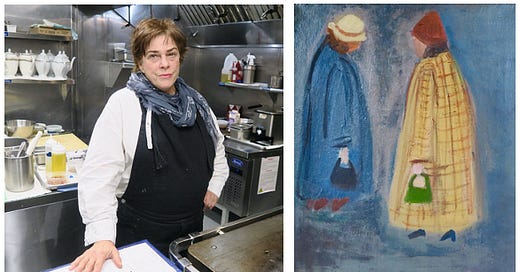



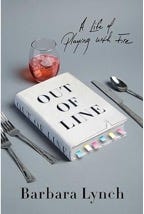
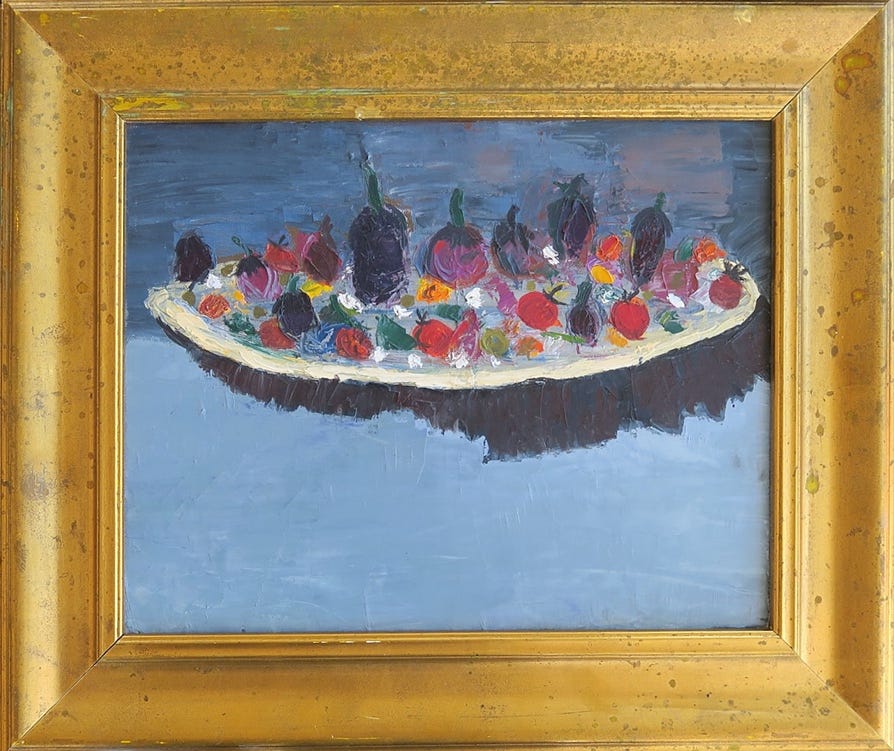


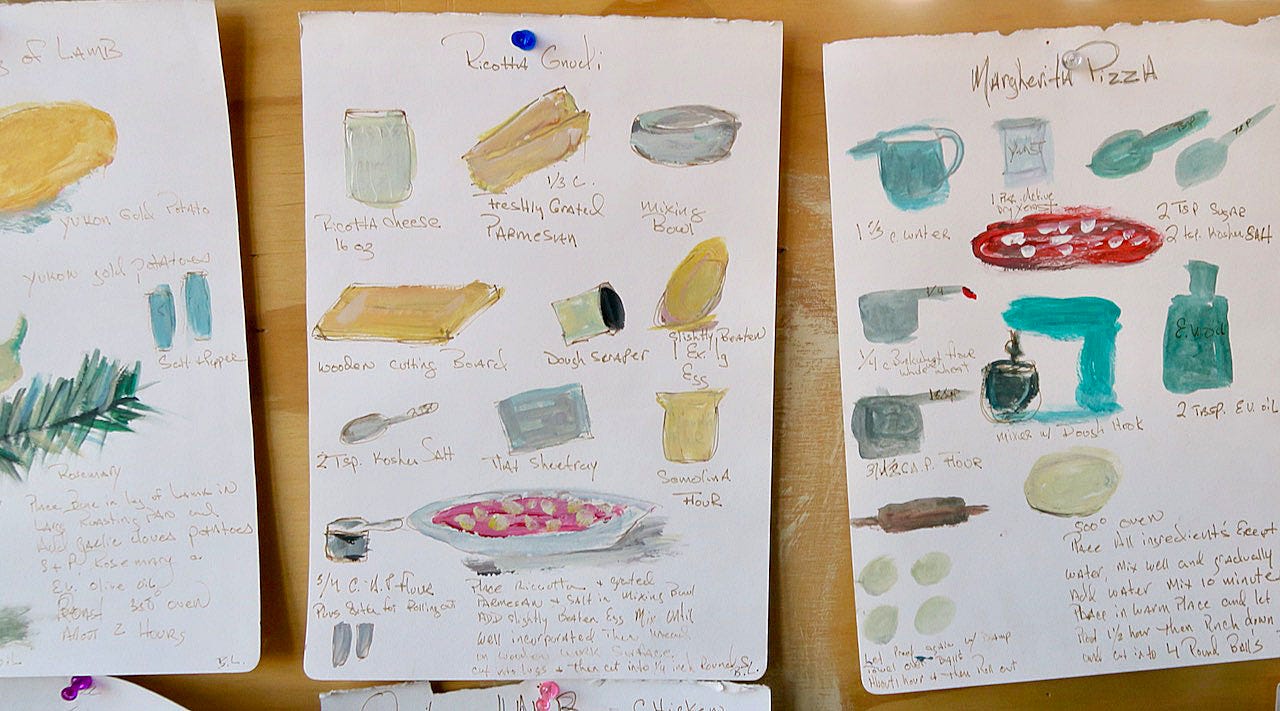
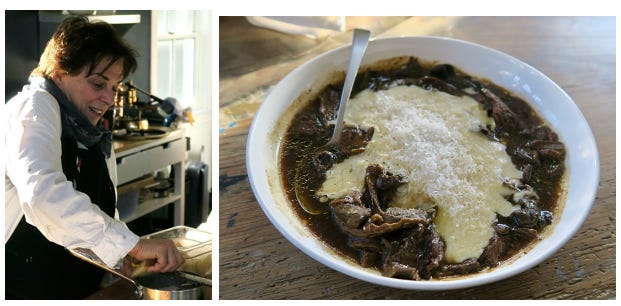
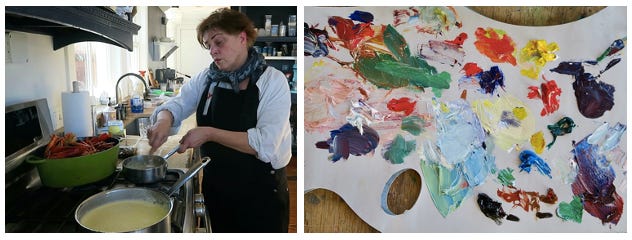

I'll check out her restaurant this summer. Maybe there will be something I can eat? I always enjoy what you cook for me, Amy.
Wow! So much great information. I have to go back and re-read! Interesting about Jacques Pepin and HoJos. That porridge looks delicious.